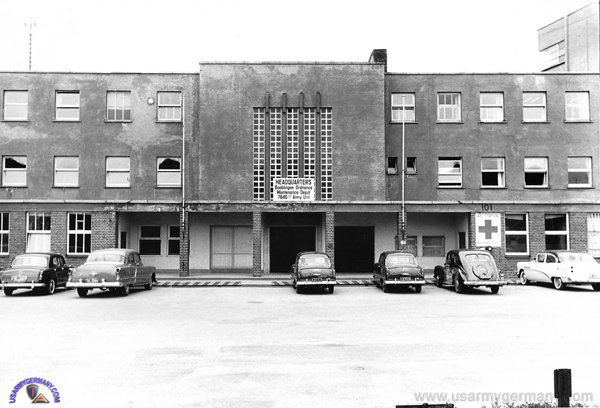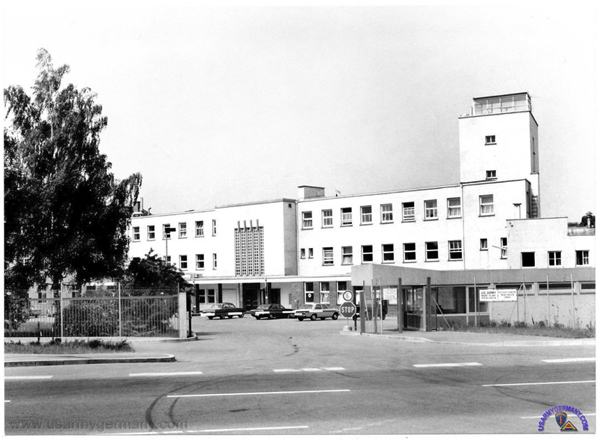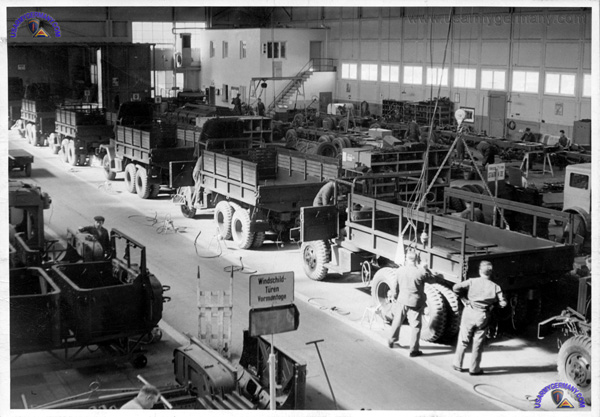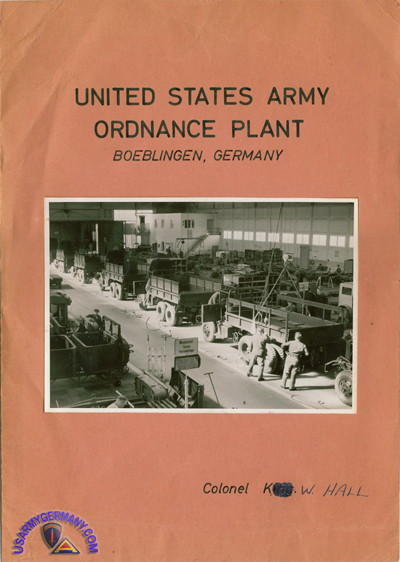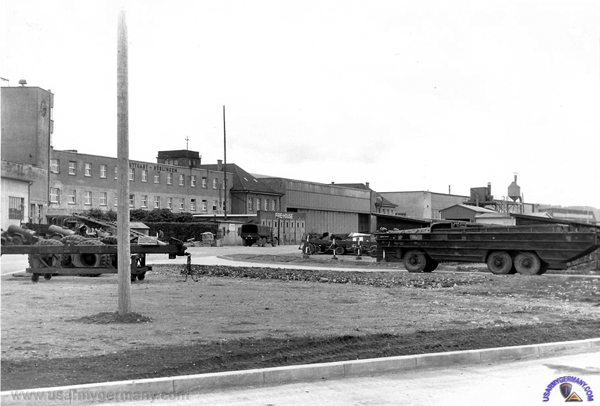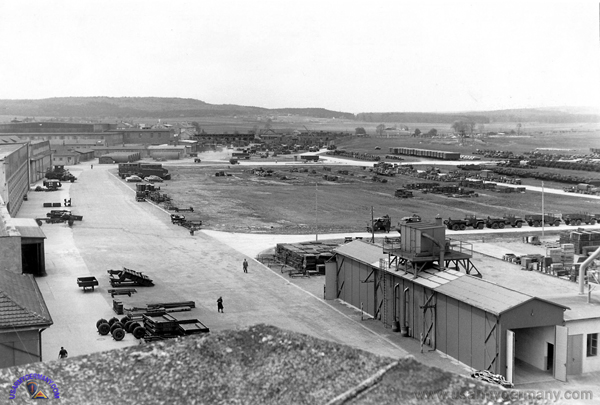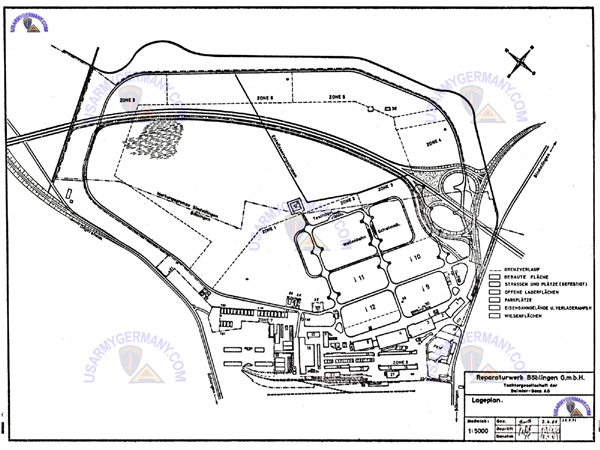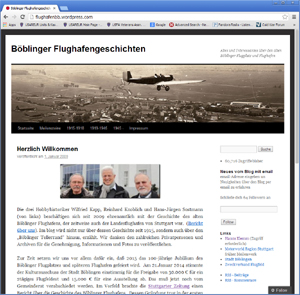| If you do
NOT see the Table of Contents frame to the left of this page, then
Click here to open 'USArmyGermany' frameset |
||||
|
Böblingen Maintenance Facility |
||||
|
|
||||
|
||||
|
|
||||
|
||||
| Depot History | ||||
| 1954 | ||||
| (Source: STARS & STRIPES, May 11, 1954) | ||||
| In May 1954, HQ USAREUR announced that the nine-year vehicle rebuild program would be reduced by the end of 1955 from the original 14 rebuild installations to four. The Boeblingen Ordnance Maintenance Plant would be one of the four remaining rebuild depots. Boeblingen, together with the Mainz Ordnance Depot, would become the center of future rebuild activity for USAREUR, USAFE and USFA. (Webmaster note: a question arises when looking at the selection of plants for the ongoing rebuild activity. Was Boeblingen responsibile for work on vehicles in the Southern Area Command area and Mainz for the Northern Area Command?) |
||||
|
|
||||
| 1955 | ||||
| (Source: STARS & STRIPES, May 25, 1955) | ||||
| The Boeblingen Ord Maint Plant sits on a former German airfield. The airfield has been converted to a depot facility - with more than 1,000,000 square feet of shop space and 600,000 square feet of storage space - that rebuilds nearly 200 vehicle a month and returns them to the Army's supply system ready for use again. The former hangars of the German airfield are now used to house mass-production lines for overall general purpose vehicle repair and general face lifiting. Work includes cleaning and disassembly, frame, body, cab repair, engine and power train reconditioning, assembly of motor vehicles and trailers, painting, spring and radiator repair, sandblasting, and carpenter work. The mission of the plant is to provide maintenance of transport vehicles; handling of returned material; maintenance of vehicles in storage; manufacture of parts; modifications on vehicles as required; and receipt, storage and issue of unserviceable or excess stock. CO of the plant is Col Nathanial W. Koeneman. His staff includes six officers, six enlisted men and eight Department of the Army civilians; in addition, close to 1,000 German civilians work at the depot. At present, the depot turns out an average of 12 2½ -ton trucks, 25 ¾-ton trucks, 40 jeeps, 30 semitrailers, 60 trailers and 10 sedans every month. MISCELLANEOUS INFORMATION An article found in the Aug 12, 1954 issue of the STRIPES indicates that the storage space at Boeblingen was nearly 6,000,000 square feet - not 600,000 as mentioned in an earlier article. The installation itself covers an area of 242 acres. Rebuild operations at the Boeblingen plant began in April 1947. Before that, the facility (airfield) served as a collecting point and vehicle park. In October 1953, the installation came under the 53rd Ord Gp. |
||||
| If you have more information on the history or organization of the Boeblingen Maintenance Facility, please contact me |
||||
| 1978 | ||||
| (Source: Email from Bernhard Wädekin, Germany) | ||||
I think, BMF or BMP (Boeblingen Maintenance Plant) deserves much more space … The rail head was used to transport the tanks out of Panzer Kaserne (1/4 CAV). During 1979 (??) REFORGER, BMF was tent city, tank cleaning and customs inspection for troops returning from the exercise. |
||||
| (Source: Information collected by the Böblinger Flughafengeschichten historians and the webmaster) | ||||
| The Boeblingen airfield (1) came under US Army control in June 1945, when US units moved into the Stuttgart area as part of the assumption of a permanent zone of occupation by US Forces. (French forces, previously located in the Stuttgart area, withdrew to the French Zone. Disposition of allied troops in their final zones of occupation was to be accomplished by VE+60.)
It appears that by July 1945, the US Army (probably Seventh Army service troops) had set up an Ordnance Depot and Collecting Point at the Boeblingen airfield. Collecting points were set up throughout the US Zone to receive equipment and supplies from organizations and units leaving the Theater for redeployment. Personnel at these collecting points were responsible for performing identification, classification, segregation, rehabilitation and storage maintenance on the turned-in equipment and supplies. According to information collected by the Böblinger Flughafengeschichten historians (BFH), over 4,000 combat, general and special purpose vehicles, artillery pieces, and other equipment was turned in to this collecting point. In the November TSFET Progress Report, a list of depots in Germany is provided for that reporting period. The installation at the Boeblingen Airfield is listed as the Boeblingen Ordnance Service Vehicle park. Total number of depot personnel is cited as 1,617 -- of which 40 percent were US military. (The other Vehicle Parks were: Butzbach, Kassel (2), Nürnberg, & Karlsfeld.) The STATION LIST for September 1 1948, shows that Detachment #4, 7845th Ordnance Maintenance Group operated the Böblingen Ord Depot, under the command of the Base Maintenance Center at Esslingen. |
||||
| On June 1 1948, the Boeblingen Rebuild Depot was converted to a GOCO (government owned/contractor operated) facility - with Daimler-Benz in Stuttgart-Untertürkheim providing contract operations. The initail contract was for two years. A new contract in 1950 was awarded to Kessler & Co in Wasseralfingen. On April 1 1956, Daimler-Benz again took over contract operations. | ||||
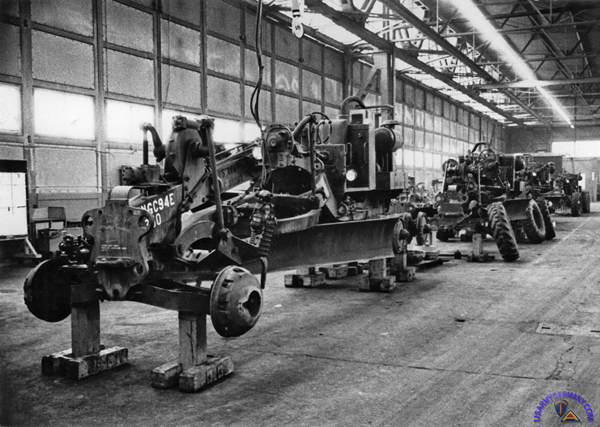 Heavy construction equipment: road graders being overhauled |
||||
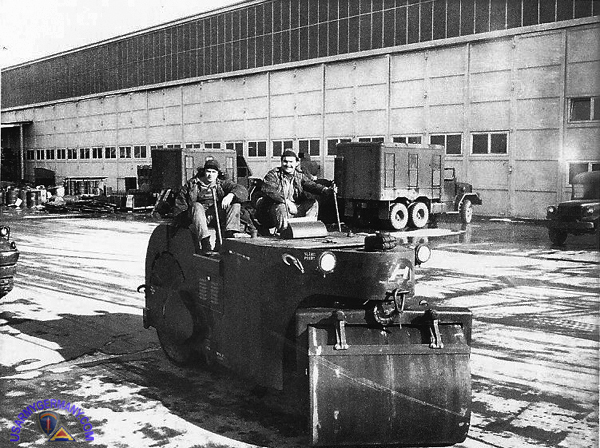 Two depot employees put a roller through its paces after overhaul |
||||
| In January 1957, the facility was transferred from USAREUR to the Communications Zone and redesignated as US Army Ordnance Depot Boeblingen. The transfer was part of a major realignment of logistical functions between USAREUR and the COMZ. The Boeblingen Rebuild Plant was inactivated in October 1975. |
||||
| (1) Originally constructed as a fliegerhorst for the German air force in WWI, converted to a civilian airport for the Stuttgart area after that war, then remilitarized by the NAZI's in the 30s and used as a fighter base during WWII. (2) Source: TSFET Progress Report, October 1945. (3) Source: Supply: Procurement, Storage and Issue, 1947. OCCUPATION FORCES Series. (4) Some of the other rebuild plants were: Esslingen, Waiblingen, Neckarsulm, Stuttgart, Aalen, Schwäbisch Gmünd, Rüsselsheim, Bad Cannstatt, and Heilbronn. |
||||
|
|
||||
| Related Links: | ||||
|
||||

